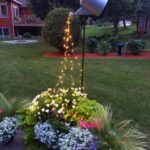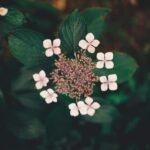Designing a very small forest garden urban layout involves carefully planning and maximizing space to create a thriving green oasis within an urban setting. This innovative concept offers numerous benefits for urban dwellers, including access to fresh produce, improved air quality, and a tranquil natural environment in the midst of the city bustle.
Forest gardening is based on the principles of mimicking the structure and function of natural ecosystems, creating a sustainable and low-maintenance garden that provides a variety of edible and medicinal plants. By understanding the basics of forest gardening, such as plant selection, layering, and biodiversity, urban gardeners can transform even the smallest spaces into flourishing green havens.
Assessing the available space is crucial when designing a very small forest garden urban layout. Understanding how to evaluate the feasibility and potential for a forest garden in an urban setting will help determine the best approach for creating a lush and productive garden. With careful planning and consideration for factors such as sunlight, water availability, and soil quality, even the tiniest urban space can be converted into a vibrant forest garden.
The Basics of Forest Gardening
Designing a very small forest garden urban layout requires a deep understanding of the principles and key elements of forest gardening. One of the main aspects of forest gardening is plant selection, which involves choosing a variety of plants that can thrive in the urban environment while also fulfilling different ecological niches. This includes fruit trees, berry bushes, perennial vegetables, and herbs to create a multi-layered canopy similar to that of a natural forest.
Biodiversity is another essential consideration in forest gardening as it contributes to the resilience and health of the ecosystem. By incorporating a wide range of plant species, urban forest gardens can support diverse pollinators and beneficial insects.
Layering is another crucial aspect to consider when designing a small forest garden in an urban setting. Mimicking the structure of natural forests, these gardens are typically divided into several layers including tall trees, smaller trees, shrubs, herbaceous plants, ground covers, and vines. Each layer serves different functions within the ecosystem and helps maximize space within the limited area available in urban environments.
In order to achieve success with very small forest garden layouts in urban areas, it’s important for urban dwellers to understand these basic principles and elements involved in creating such a unique and rewarding space. By carefully selecting plants, incorporating biodiversity, and optimizing layering techniques, even the smallest urban space can be transformed into a thriving miniature forest ecosystem.
| Principles | Key Elements |
|---|---|
| Plant Selection | Fruit trees, berry bushes, perennial vegetables |
| Biodiversity | Diverse pollinators and beneficial insects |
| Layering | Tall trees, shrubs, ground covers |
Assessing the Space
When planning to create a very small forest garden urban layout, one of the most crucial steps is assessing the available space. This will help determine the feasibility and potential for transforming the area into a thriving forest garden. Here are some tips and tricks for evaluating a small urban space:
- Measure the Area: Begin by measuring the available space to get an accurate understanding of its dimensions. This will help in determining how much can be accommodated within the area.
- Observe Sunlight Exposure: Take note of how much sunlight the space receives throughout the day and at different times of the year. This is essential for deciding which plants will thrive in the given conditions.
- Study Soil Quality: Assess the soil quality to understand its composition and fertility levels. Conducting a soil test can provide valuable insights into what amendments may be needed for optimal plant growth.
By carefully evaluating these aspects, urban dwellers can gain a better understanding of what is feasible within their available space and make informed decisions when designing a very small forest garden urban layout.
Furthermore, it is important to consider any challenges or limitations that may exist within the space, such as existing infrastructure, shade from neighboring buildings, or access to water sources. By addressing these factors during the assessment phase, individuals can proactively plan for potential obstacles and develop creative solutions to overcome them when designing their urban forest garden.
Designing the Layout
Assessing Sunlight Exposure
The first step in designing the layout of a very small forest garden is to assess the sunlight exposure in the chosen urban space. This will help determine which areas receive full sunlight, partial sunlight, or are mostly shaded. Understanding the sunlight patterns will be crucial in deciding where to place different types of plants within the garden layout.
Evaluating Water Accessibility
Another key consideration when planning a very small forest garden is evaluating water accessibility. Urban spaces may have limited access to water sources, so it is important to consider how irrigation systems can be implemented efficiently. Rainwater harvesting, drip irrigation systems, and porous materials for pathways can help maximize water usage and minimize wastage.
Testing Soil Quality
Before finalizing the layout of a forest garden, it is essential to test the soil quality in the selected urban space. Soil tests can provide valuable information about pH levels, nutrient content, and drainage capabilities. This will guide plant selection and help determine if any amendments or improvements need to be made to optimize soil health for the forest garden.
By carefully considering these key factors of sunlight exposure, water accessibility, and soil quality when designing a very small forest garden layout in an urban setting, individuals can create a thriving ecosystem that maximizes the use of available resources while providing numerous benefits for both people and the environment.
Plant Selection
When it comes to designing a very small forest garden in an urban setting, selecting the right plants is crucial for creating a sustainable and thriving ecosystem. Native species, fruit trees, and perennial herbs play a vital role in contributing to the biodiversity, productivity, and overall aesthetics of the garden. Here are some essential factors to consider when identifying the best plants for a small forest garden in an urban setting.
Native Species
Incorporating native species into your very small forest garden is not only beneficial for the local ecosystem but also ensures that the plants are well-suited to the climate and soil conditions of the area. Native species require less maintenance, have natural resistance to local pests and diseases, and provide habitat for native wildlife such as birds and pollinators.
When selecting native species for an urban forest garden, consider plants such as wildflowers, grasses, shrubs, and trees that are indigenous to your region.
Fruit Trees
Integrating fruit trees into a small urban forest garden can provide an abundant harvest of fresh produce while adding vertical layers to maximize space. Dwarf or semi-dwarf varieties of fruit trees are ideal for very small spaces, as they can be trained and pruned to fit within limited areas.
Consider planting fruit trees such as apple, pear, cherry, fig, or citrus that are suitable for urban environments. In addition to providing fruits for consumption, fruit trees also contribute to the beauty of the garden with their blossoms and foliage.
Perennial Herbs
Including perennial herbs in a very small forest garden offers both culinary and ornamental benefits. Perennial herbs such as rosemary, thyme, sage, oregano, mint, and lavender are relatively low-maintenance once established and can thrive in various growing conditions.
Their aromatic foliage attracts pollinators while adding fragrance and flavor to your urban garden space. When selecting perennial herbs for a small forest garden layout, consider their growth habits and care requirements to ensure they complement other plantings while providing year-round interest.
By carefully choosing native species, fruit trees, and perennial herbs for your very small forest garden in an urban setting, you can create a diverse and productive landscape that enhances the ecological balance of your surroundings while providing valuable resources for both humans and wildlife alike.
Maintenance and Care
Maintaining a very small forest garden in an urban setting requires ongoing care and attention to ensure the plants thrive and the ecosystem remains balanced. Here are some crucial maintenance and care practices to consider for your urban forest garden:
- Mulching: One of the essential maintenance tasks for a very small forest garden is mulching. Mulch helps retain soil moisture, suppresses weeds, regulates soil temperature, and adds organic matter to the soil as it breaks down. Use organic materials such as wood chips, straw, or leaf litter as mulch around your plantings to provide these benefits while also enhancing the aesthetic appeal of your garden.
- Watering: Proper watering is critical for the health of your plants in a small urban forest garden. Since space is limited, it is important to water efficiently to ensure that all plants receive adequate moisture. Consider using drip irrigation systems or soaker hoses to deliver water directly to the root zones of your plants. Additionally, employing water-conserving techniques such as rainwater harvesting or graywater recycling can help minimize water usage in your garden.
- Pest Control: Urban forest gardens may be susceptible to pest infestations due to their proximity to other green spaces and potential sources of pests. Implement integrated pest management strategies, including regular monitoring of plant health, encouraging natural predators like birds and beneficial insects, and using organic pest control methods when necessary. By staying proactive and vigilant, you can effectively manage pest issues without resorting to harsh chemical treatments.
By incorporating these maintenance and care practices into your routine, you can ensure the long-term success of your very small forest garden in an urban environment.
Maximizing Space
One of the biggest challenges in designing a very small forest garden urban layout is maximizing space. Urban dwellers often have limited outdoor space to work with, so finding creative and innovative ways to make the most of that space is essential. In this section, we will explore several ideas for maximizing space within a small urban forest garden, including vertical gardening, companion planting, and container gardening.
Vertical gardening is a great way to make use of limited space in a small urban forest garden. By growing plants upright on trellises, fences, or walls, you can take advantage of vertical space that might otherwise go unused. Vining plants like tomatoes, cucumbers, and beans are perfect for vertical gardening and can thrive in a small footprint.
Companion planting is another strategy for maximizing space in a very small forest garden. By planting compatible species together, you can maximize yield and minimize wasted space. For example, planting tall sun-loving crops like corn or tomatoes alongside low-growing shade-tolerant plants like lettuce or spinach can make the most of available sunlight and soil without overcrowding your garden beds.
Container gardening is also an effective way to maximize space in a small urban forest garden layout. Containers allow you to grow plants on patios, balconies, or even indoors if outdoor space is truly limited. Many fruits, herbs, and vegetables can be grown successfully in containers, making it possible to create a productive mini-forest garden even in the smallest of spaces.
| Ideas | Description |
|---|---|
| Vertical Gardening | Utilize trellises or walls to grow vining plants like tomatoes or beans. |
| Companion Planting | Grow compatible plant species together to maximize yield and minimize wasted space. |
| Container Gardening | Growing plants in containers on patios or balconies to make use of limited outdoor space. |
Case Studies
In conclusion, designing a very small forest garden urban layout is not only feasible but also incredibly beneficial for urban dwellers. The principles of forest gardening, including plant selection, layering, and biodiversity, can be adapted to fit into even the tiniest urban spaces. By carefully assessing the space available and considering key factors such as sunlight, water, and soil quality, it is possible to create a thriving green oasis in the midst of the city.
The process of designing the layout of a very small forest garden requires thoughtful planning and consideration of the unique conditions present in an urban environment. However, with the right plant selection, ongoing maintenance and care techniques, and creative use of space-maximizing strategies such as vertical gardening and companion planting, it is possible to create a successful small forest garden layout.
This can be seen in the case studies presented, showcasing before and after photos as well as interviews with urban gardeners who have implemented this design with great success.
Ultimately, implementing a very small forest garden urban layout has the potential to bring immense joy and benefits to urban dwellers. Not only does it provide access to fresh fruits, herbs, and other edible plants, but it also contributes to increased biodiversity within urban areas and creates a peaceful retreat from the hustle and bustle of city life.
With careful planning and execution, anyone can transform their small urban space into a thriving forest garden that serves both themselves and their community.
Frequently Asked Questions
How Do You Plant a Mini Forest?
Planting a mini forest involves careful planning and selection of native trees, shrubs, and ground cover plants. Start by choosing a variety of plant species that will thrive in your local climate and soil conditions. Create layers within the forest, with taller trees at the back and smaller plants in the front.
Consider the spacing between each plant to allow for ample growth. It’s important to provide ongoing care, including watering, mulching, and occasional pruning to ensure the mini forest flourishes.
How Do You Structure a Small Garden?
Structuring a small garden requires maximizing the available space while creating visually appealing and functional areas. Start by determining the purpose of the garden – whether it’s for growing vegetables, flowers, or simply as an outdoor relaxation space.
Divide the garden into sections or beds using paths or edging materials to create a sense of organization. Consider utilizing vertical space with trellises or hanging planters to maximize planting area.
How Do I Make My Small Backyard Look Like a Forest?
To make a small backyard look like a forest, begin by selecting native tree species that are suitable for your region’s climate and soil conditions. Arrange these trees throughout the backyard to mimic a natural woodland setting. Incorporate understory plants such as shrubs and ground cover to fill in spaces between the trees and create layers of vegetation.
Adding natural elements like rocks, logs, and a water feature can further enhance the forest-like ambiance in your small backyard. Finally, consider incorporating winding pathways to meander through the “forest” for an immersive experience.

Welcome to my gardening blog! I am passionate about plants and enjoy sharing my knowledge and experiences with others. In this blog, I will write about everything related to gardening, from tips on how to get started to updates on my own garden projects.





